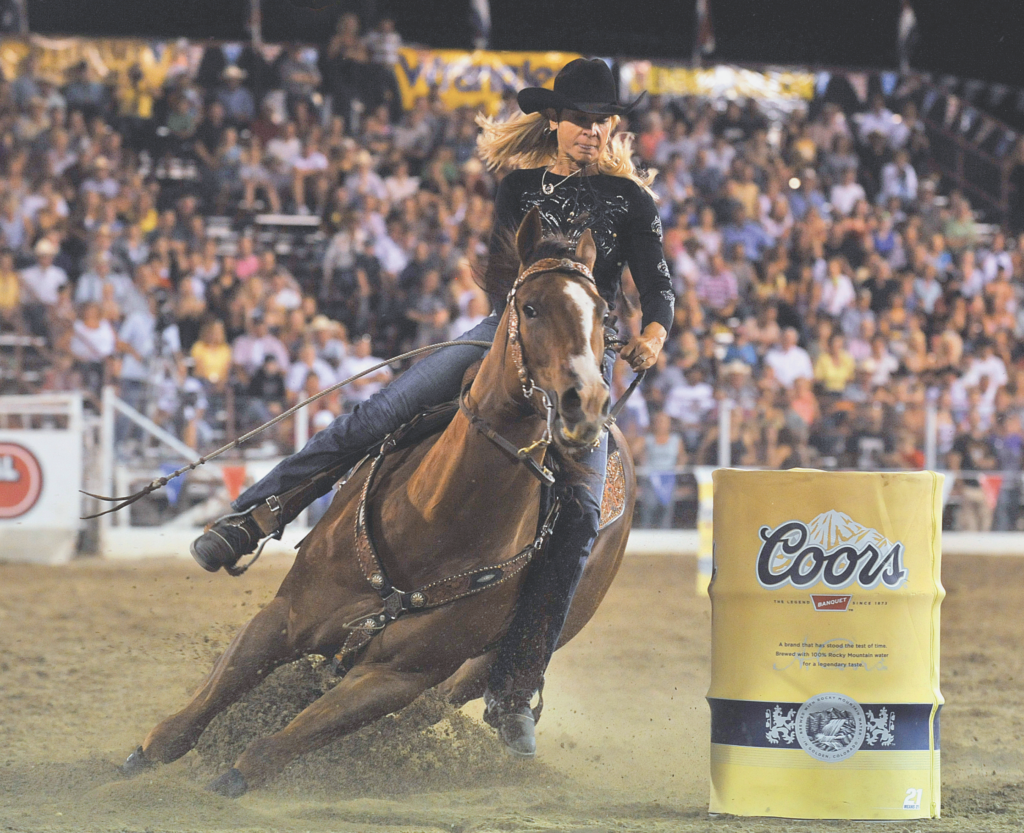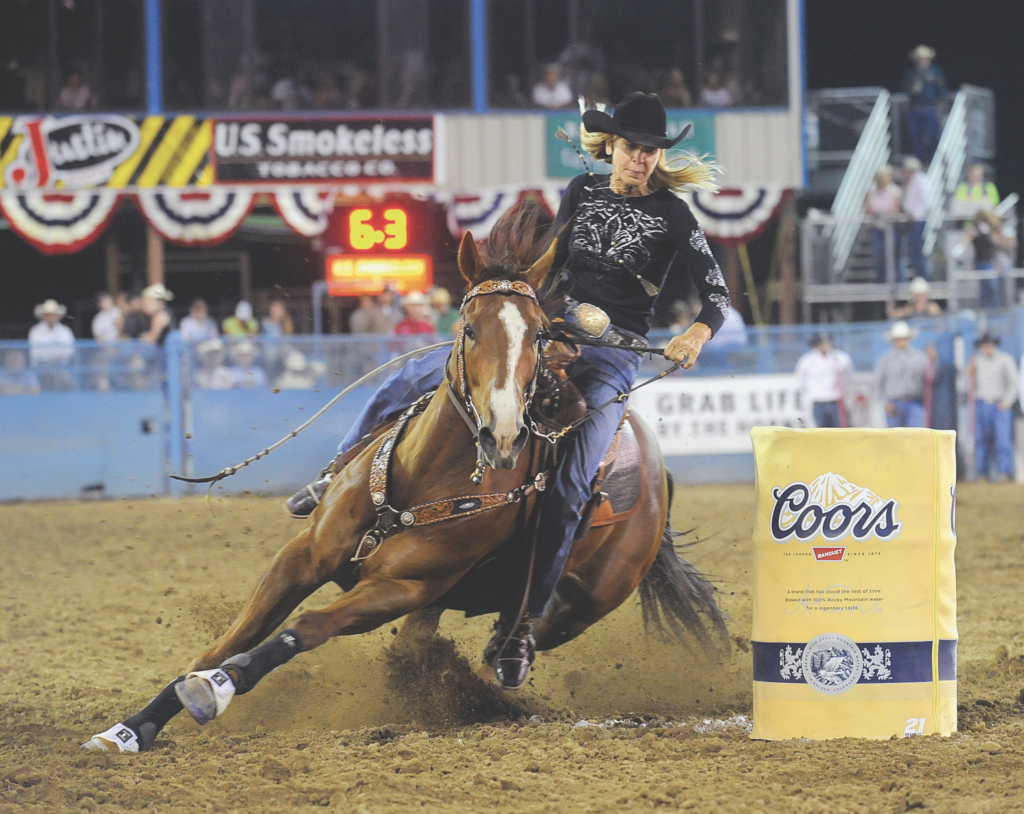Sue Smith went to just 31 rodeos this year en route to qualifying for her first Wrangler NFR, when her goal had just been to make her circuit finals and get qualified for the winter building rodeos that she missed in 2009.
Originally published in Spin to Win Rodeo, 2010
“It just happened to go the right way,” she said. “I didn’t get too crazy. I went to the Northwest this fall and mostly to Tour rodeos. I just happened to hit right.”
It wasn’t until the always-tough trainer burst into the top 15 after winning Bremerton, Wash., that the NFR worked its way into her mind. “It’s all fun until you actually get in the standings and then have to stay there,” she cracked.
But despite her light rodeo schedule, Sue Smith, of Blackfoot, Idaho, is one busy woman. In addition to having the best year of her career on a horse she trained from the ground up, Smith does her own farrier work, makes her own headstalls and breastcollars, teaches clinics, and is training handfuls of upcoming equine stars. It’s no wonder she hasn’t found time to set a date for her wedding to her fiancé, Kyle Edwards.
Her NFR horse, the fabulous Real Claim Ta Fame (“Claimer”), is only 6 years old but has taken to professional rodeo like a duck to water two years after earning more than $60,000 at the futurities. Smith picked up the Dash Ta Fame son as a yearling in Ruidoso, N.M., and sent him to the racetrack, where he didn’t exactly shine.
“He was little and kind of goofy, and he was that way on the barrels, too,” she recalled. “He wouldn’t really concentrate for a long time. I tried to sell him and nobody would buy him.”
Already, Claimer’s been clocked under 17 seconds on a standard pattern six times, including a 16.9-second run in Reno that earned Smith nearly $9,000. He’s not the first of his caliber that she’s produced. Smith also trained JDC Best Efforts (“JD”), on whom she won the Wilderness Circuit in 2002 and on whom Molly Powell won an Olympic gold medal and Danyelle Campbell ran at the NFR. And she made the late 6-year-old Willie B Rockin, on whom Jill Miller set an arena record at Cody this year.
Smith’s success is partly due to her sticky attention to detail. Each of her bits is custom-made, and she shoes her own horse. At Ellensburg when the ground got slick, she hammered some mud nails into Claimer’s rims to give him more traction. “The more you can help your horse, the more you help yourself,” she explains.
When she can fit them in, she also does clinics, and says she’s enjoyed the people she’s met and the feedback she’s gotten.
“Some of my students come up and do good, and that’s pretty rewarding for me,” says Smith, who finished alongside two of her former students in the top three this year at a race in Washington.
Sue Smith, whose grown son is a competitive hunter and fisherman, spends winters in Arizona where she’s up to her ears in promising colts, including four 2-year-olds and four yearlings she raised, plus a couple more Dash Ta Fame 2-year-olds.
To juggle all the facets of her career, Smith just goes with the flow. If she has a tough futurity horse, she makes that a priority. If she has a tough Open horse, it’s the rodeos.
“Next year, I’m going to try to fit it all in,” she says. “I don’t go crazy on the rodeoing because I just like riding my colts too much.”
Winning Nampa, Idaho

Wherever my hand goes, I want my horse’s feet to follow. And the only way I can get a horse that free in the front end is to have him breaking correctly at the poll. Also, I think if a horse stands up more in his turns, he handles the ground better and doesn’t take up as much room getting around the turn.
I believe that wherever you look, your shoulders point that way, and I like to keep my shoulders in the middle of my horse where my balance is the best. I keep them as much over my pelvis as I can.
I use rubber bands on my stirrups to make sure I don’t lose a stirrup, which can drop me on my butt. But I like just my toes over my stirrup and not the ball of my foot, so rather than putting the rubber band around my foot, I put it around the stirrup, place my foot where I want it, and then just push the rubber band down to the bottom on each side. It’s a little different.
Winning Caldwell, Idaho

My hand position depends on what my horse is doing. If I was headed into the turn, my hand would be lifting, and it rotates more toward the barrel the further I get around it. Here I’m leading my horse around the turn, about to ask him to leave it.
My philosophy on training is to always look ahead, and that’s where you’ll end up. I look first at where I’ll rate, then at the backside, and then at that last corner of the turn. You can be riding in a straight line and if you even tip your head, it tilts your pelvis and makes your horse move away from that pressure. I actually use a fairly thin pad so my horse can feel that signal through the saddle.
You can see here that I also use my legs to turn my horse. By twisting, I’m applying pressure on the inside of the ribcage to keep him round and bending around my leg. I train using this so my horse is really in tune to me and I don’t have to think about it in a run.
Winning the Reno Short Round

Claimer was hauling butt when he ran this 16.9. He bobbled approaching the third barrel when he spotted the guys raking the other barrels, so I couldn’t believe the time!
This second barrel at Reno is off the bucking chutes a ways, and he was a little freer there. This positioning, to me, is ideal because if a horse has more room at that point in the turn, he can be really quick.
I like my horses balanced so they can run around the turn more than anything. And if a horse is turning really tight, a lot of times that’s slower because he takes too many steps.
When I’m training, once a horse rates, I want him to speed back up so he’s going somewhere. In this picture, I love the way Claimer’s really reaching and still coming around. He’s not crowding me to where I have to have my hand lifted to get through. I can just ride him through the turn by bringing my hand to the inside. SWR
Learn from today’s top pros at Ride TV.






